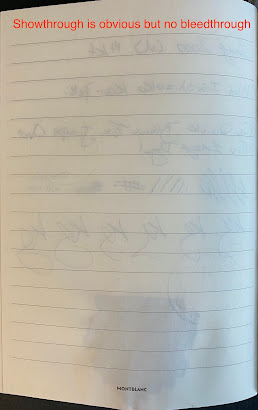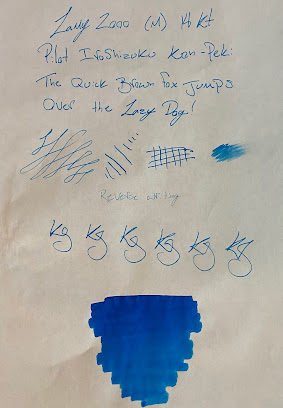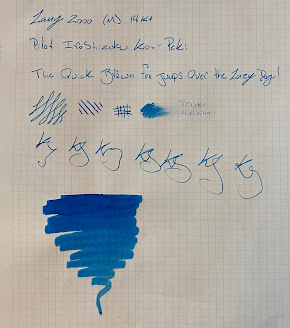Introduction:
Paper has been such a constant in eveybody's life that we tend to forget that not all paper is the same, not just whether its graph, lined, grid, etc. but also the qualities of the paper, how it deals with different pen types, the bleed through, the feathering, dry time and things of this nature. The difference in paper will be most clear when a fountain pen is used so for the sake of the comparison I'll be using the same fountain pen with the same ink on all the different paper in this example. The pen I'll be using is the
Lamy 2000 in a medium nib size inked with
Pilot Iroshizuku Kon-Peki which I feel are widely popular and an appropriate choice for the sake of this example. The paper brands I'll be comparing are Rhodia, Clairefontaine, Montblanc, Tomoe river, Mnemosyne, and the Write pad.
Let's meet our competitors:
- Rhodia- Arguably the most accessible brand I'll be comparing is Rhodia as they are available in an abundance of different types of stores, I've even seen them available in art stores and craft stores. The Rhodia brand offers a wide variety of sizes on 80 gsm paper and sometimes even 90 gsm paper however the 80 gsm seems to be more common. In 1997 Rhodia was purchased by Clairfontaine (another brand I'll be comparing later on) but some of the founder's family stayed on with the brand after this purchase, all Rhodia pads are made in France just like in 1932 when the brand was founded and still known as the Verilhac Brothers.

- Clairefontaine- Another staple of French paper manufacturing is Clairefontaine who, as I mentioned earlier, acquired Rhodia relatively recently in 1997. Clairefontaine has been making paper in France for over 150 years and actually started their production in 1858. Unlike Rhodia, Clairefontaine is primarily offered in 90 gsm paper this means it will be a tiny bit heavier than the Rhodia paper. The paper comes in a couple different sizes but not as many unique sizes that a company like Rhodia provides, more of the usual spiral bound or cloth bound sizes.

- Montblanc- Next we have a company that really needs no introduction, whether you are just starting your journey into the fountain pen hobby or are a seasoned veteran, you've heard of Montblanc. Arguably the most famous pen company in the world, Montblanc not only makes pens but also makes notebooks that are leather bound with 85 gsm paper sheets. While they are more expensive, these notebooks aren't really meant for everyday note taking, in my mind they are meant for something like journaling or an activity that you want to keep a record of due to the high build quality and high end materials.

- Tomoe River- If you ask any fountain pen user their favorite type of paper there's a fairly good chance they'll answer with Tomoe River paper. Tomoe River paper used to be quite hard to get with only 1 or 2 vendors in the United States having it but is now widely coveted and available in the United States. The paper is unusually thin for fountain pen paper and is offered in 52 gsm and 68 gsm which are also relatively low for fountain pen paper. Despite the thin profile of each sheet, it handles fountain pens beautifully and really stands out amongst other brands due to the uniqueness of the product at hand. PenBoutique carries the Sakae Technical version of the loose sheets in A4 size in both plain and dot grid. It also comes in a pad or cloth bound notebook closer to an A5 size. This paper's lightweight feel isn't for everyone and some people opt for a thicker paper which is understandable because it takes some getting used to if you are used to writing on higher gsm papers.

- Mnemosyne- Like Tomoe River paper, Mnemosyne is also a Japanese brand that offers exceptional experience while writing with a fountain pen. The paper is manufactured by Maruman and comes spiral bound in a variety of sizes and paper types including grid, plain and lined, the paper's weight is 80 gsm. This is a particularly good line of products for students and business people because each page has a dedicated space for a title and date making it good for taking notes in class or a meeting. The Maruman brand has been in the business for over 90 years and their dedication to the quality of their product is reflected in this fact.

- Write Notepads- the last brand that will be included in this comparison is a local company from Baltimore that makes quality notebooks out of environmentally friendly materials like vegetable based dyes, premium cover stock and 110 gsm paper. The heavy paper makes these notebooks a good option for drawing as well as note taking. Most of their offerings are spiral bound but they also have a classic hardcover version of a notebook as well. The brand is an off shoot of a book binding company and their three generations of expertise in the subject shine through in the quality and craftsmanship of their notebooks.
Putting Them to the Test:
Below are the pictures of the samples I created on each brand of paper listed with the same pen and ink to make it a good comparison of how the same pen acts on different paper.
Rhodia:
Clairfontaine:
Montblanc:
Tomoe River:
Mnemosyne:
Write Notepads:
Show through/Ghosting:
Show-through is an important aspect of paper because it affects the legibility of the back of the paper, if you can see everything from the front of the page on the back it may be harder to read. Show-through is different than bleed through because show through just means the other side of the page can be seen, bleed through is an over saturation of ink that comes through to the other side of the paper.
|
Brands
|
Show-Through
|
Feathering
|
Dry-Time
|
Paper Texture
|
Price
|
|
Rhodia
|
Low
|
|
|
|
|
|
Clairfontaine
|
Medium
|
|
|
|
|
|
Montblanc
|
High
|
|
|
|
|
|
Tomoe River
|
High
|
|
|
|
|
|
Mnemosyne
|
Low
|
|
|
|
|
|
Write Notepads
|
Low
|
|
|
|
|
Best in category: Write Notepads
The reason they win the bleed through test is because they are the thickest and heaviest paper out of the bunch at 110 gsm. This means that there is more paper behind the ink to absorb so it doesn't even show through the other side. Even with the swab of ink it can't be seen from the other side, only leaves a slight warping where the swab was applied. This makes the write notepads a strong option for people drawing with their fountain pens whether you need a sketchbook or you draw while you journal, the low bleed through allows you to have crisp clean pages on each side of the sheet.
Feathering:
Feathering can be very annoying when using a fountain pen and luckily most higher quality paper tackles this issue quite nicely. Feathering is when ink from what you are writing spreads from the line you drew making the line appear messy and more broad than the nib size you may be using. When using a fountain pen there a bunch of different nib sizes and you want those to be true, not be ruined by feathering making your line appear messy and not as crisp.
Brands | Show-Through | Feathering | Dry-Time | Paper Texture | Price |
Rhodia | Low | light |
|
|
|
Clairfontaine | Medium | light |
|
|
|
Montblanc | High | light |
|
|
|
Tomoe River | High | light |
|
|
|
Mnemosyne | Low | light |
|
|
|
Write Notepads | Low | light |
|
|
|
Best in category: Mnemosyne
It was really hard to pick a winner for this category because all of the paper performed so well and had light feathering. You could really pick up any of these paper brands and not have to worry about feathering but Mnemosyne edged it out just a little better with clean and crisp lines. Mnemosyne paper is right around the same weight as Montblanc, Clairefontaine and Rhodia so the difference is by no means major but performs a tad bit better in terms of feathering than those other brands. But again, you don't really have to worry about feathering with any of these brands.
Dry Time:
Dry time is probably one of the most noticeable things when using a fountain pen especially if the pen being used has a high ink flow. Paper needs to be absorbent but this is a fine line to walk because if its too absorbent it can lead to feathering and bleed though. Fountain pens by nature are going to take longer to dry than something like a ballpoint which is virtually dry once it hits the page so a quick dry time is better to minimize smudges and messy hands or paper.
Brands | Show-Through | Feathering | Dry-Time | Paper Texture | Price |
Rhodia | Low | light | medium |
|
|
Clairfontaine | Medium | light | low |
|
|
Montblanc | High | light | low |
|
|
Tomoe River | High | light | medium |
|
|
Mnemosyne | Low | light | low |
|
|
Write Notepads | Low | light | low |
|
|
Best in category: Clairefontaine
To test the dry time I wrote Dry Time Test and then timed it after I completed writing the three words, Clairefontaine dried in 8 seconds which is quite good. This problem can also be combated with a blotter sheet or a hand held blotter so if a paper has medium dry time there is a solution to prevent smudging and ink spreading. The other paper with low dry times dried only a second or two after the Clairefontaine so again, no huge gaps between all the low dry time papers.
Paper Texture:
Paper Texture and weight affect not only the thickness of the paper but also the behavior of a fountain pen on that paper. Something with a higher weight in gsm (grams per square meter) will likely be smoother than something with a lower weight. Usually you see really high gsm with art paper meant for watercolors or markers so higher gsm is also better for drawing or painting. This doesn't necessarily mean that a paper with a higher gsm is definitively better but simply that the paper will perform differently, high quality paper comes in a variety of gsm so lower doesn't mean worse.
Brands | Show-Through | Feathering | Dry-Time | Paper Texture | Price |
Rhodia | Low | light | medium | 80-90 gsm / smooth |
|
Clairfontaine | Medium | light | low | 90 gsm / smooth |
|
Montblanc | High | light | low | 85 gsm / smooth |
|
Tomoe River | High | light | medium | 52-68 gsm / smooth but thin |
|
Mnemosyne | Low | light | low | 80 gsm / smooth |
|
Write Notepads | Low | light | low | 110 gsm / very smooth |
|
Best in Category: It depends
While looking at this table above the clear winner would be write notepads however the reason I didn't pick them is due to the fact that people may need or prefer different weights of paper and smoothness. Tomoe River paper for example, is the lightest and thinnest paper in the list and is beloved by many due to its thin but well behaved sheets but the thinness makes it a polarizing feature that people tend to love or hate. The same could be said about the write notepad being too thick or smooth for some people or nibs. This category is more based on a personal feel and preference so its hard to pick one that is the "best".
Price $-$$$:
Now to arguably the most important point when comparing any product, the price. High quality paper does not have to be expensive, it's going to be a little more than loose leaf from an office supply store but we do still carry some reasonable options that are packed with value for the price.
Brands | Show-Through | Feathering | Dry-Time | Paper Texture | Price |
Rhodia | Low | light | medium | 80-90 gsm / smooth | $1.60-25.95 |
Clairfontaine | Medium | light | low | 90 gsm / smooth | $3.95-$12.00 |
Montblanc | High | light | low | 85 gsm / smooth | $44-$140 |
Tomoe River | High | light | medium | 52-68 gsm / smooth but thin | $11.40-$29.00 |
Mnemosyne | Low | light | low | 80 gsm / smooth | $6.80-$15.00 |
Write Notepads | Low | light | low | 110 gsm / very smooth | $8.99-$24.00 |
Best in category: Rhodia
The sheer amount of different sizes, binding styles, and the choice between 80-90 gsm on some of their products makes Rhodia the best price value. They are also more widely available than the other brands mentioned because I've seen them at pen stores, art stores and craft stores. The other brands here aside from the obvious price jump for Montblanc are also great values for the quality of paper and unique feelings and performance they each provide. This is not to say the Montblanc notebooks are in anyway bad, they are a luxury brand and the price reflects this fact, they also come in interesting themes to go with some of their limited edition pen models making them a good choice for a dedicated journal or something that you want to keep for years to come.
Overall:
You really can't go wrong with any of the paper brands I mentioned, most of them are over 50 years old which should tell you the level of quality they've grown to expect and provide in their products. There is something here for every price point whether you're looking for quality everyday items or a luxury products for special occasions or journal keeping! No matter what you pick, enjoy it and keep writing!
-Kyle

























Thanks for the comparison of the papers. I hadn't known about Write Notepads before, but will have to try them out.
ReplyDeleteRuth
Thanks for the comparisons! I hadn't known about Write Notepads before.
ReplyDeleteRuth